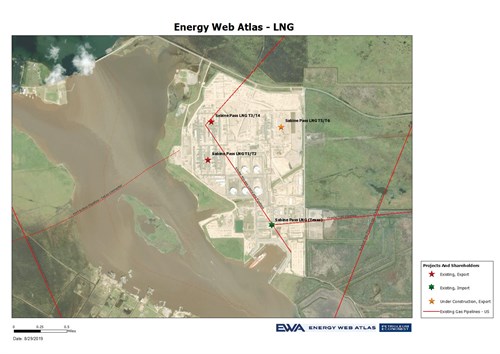Sabine Pass LNG berth expansion receives positive environmental review
Cheniere Energy received a positive environmental assessment from the Federal Regulatory Commission (FERC) for a marine berth expansion project at its Sabine Pass LNG export terminal in Cameron Parish, Louisiana.
 |
| Source: EWA |
The FERC assessment determined that the authorization of the project would not have major environmental impacts if the developer complies with recommended construction and mitigation measures.
Cheniere Energy proposed to construct and operate a third berth at the existing Sabine Pass LNG facility, which recently made a final investment decision for the construction of a sixth liquefaction train. The proposed expansion of the terminal includes the addition of a third marine berth and supporting facilities.
The third berth will be used to load LNG vessels for export and is sized to accommodate vessels with a capacity of 125,000 to 180,000 cubic meters.
The supporting facilities will include tie-ins to the existing loading lines and boil-off gas lines associated with the five existing LNG tanks.
The project will also include the addition of piping, piperacks, utilities, and other additional infrastructure to transport the LNG from the new tie-ins to the third berth.
Cheniere Energy received a positive environmental assessment from the Federal Regulatory Commission (FERC) for a marine berth expansion project at its Sabine Pass LNG export terminal in Cameron Parish, Louisiana.
The FERC assessment determined that the authorization of the project would not have major environmental impacts if the developer complies with recommended construction and mitigation measures.
Cheniere Energy proposed to construct and operate a third berth at the existing Sabine Pass LNG facility, which recently made a final investment decision for the construction of a sixth liquefaction train. The proposed expansion of the terminal includes the addition of a third marine berth and supporting facilities.
The third berth will be used to load LNG vessels for export and is sized to accommodate vessels with a capacity of 125,000 to 180,000 cubic meters.
The supporting facilities will include tie-ins to the existing loading lines and boil-off gas lines associated with the five existing LNG tanks.
The project will also include the addition of piping, piperacks, utilities, and other additional infrastructure to transport the LNG from the new tie-ins to the third berth.

- ExxonMobil halts 1-Bft3d blue hydrogen project in Texas
- Aramco and Yokogawa commission multiple autonomous control AI agents at Fadhili gas plant
- Ukraine will resume gas imports via Transbalkan route in November
- Mitsubishi to inject $260 MM into Brunei LNG project
- Freeport LNG (U.S.) on track to take in more natgas on Thursday after unit outage



Comments